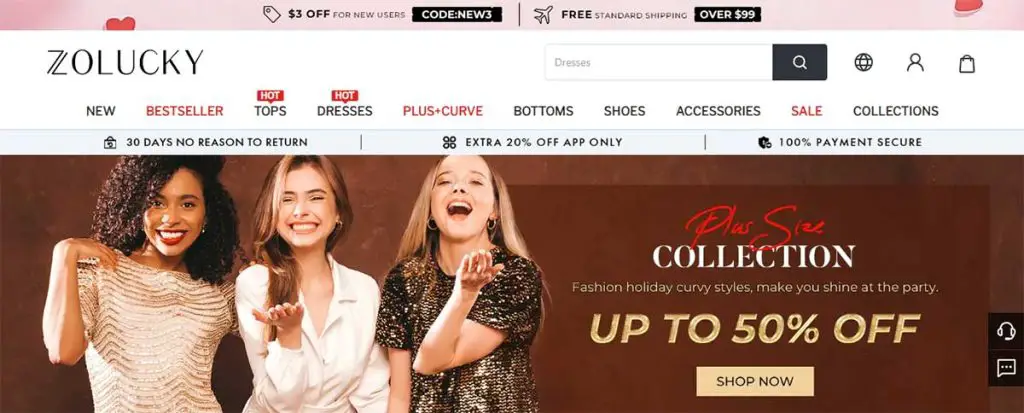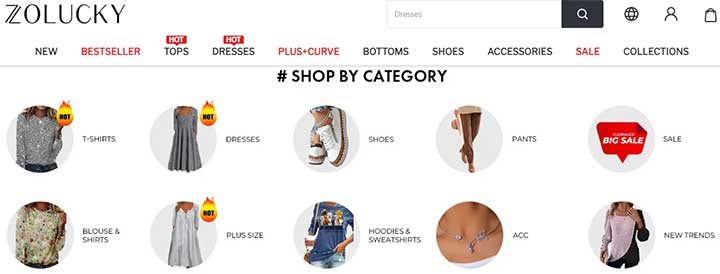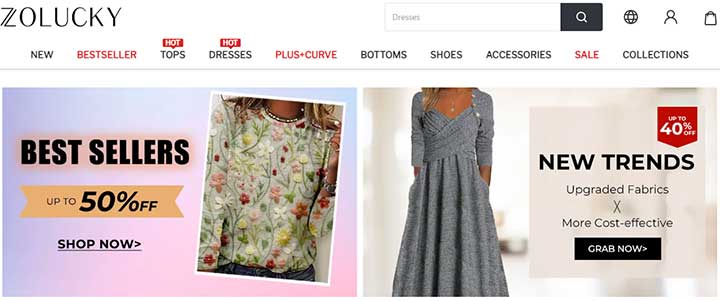Zolucky has quickly become a leading ultra-fast fashion e-retailer by offering extremely low prices. This article provides an in-depth look at how Zolucky maintains such inexpensive pricing across their operations.
We’ll explore their use of aggressive cost-cutting measures, optimized supply chain efficiency, overseas manufacturing, limited quality control, minimal customer service, predictive algorithms and other key strategies.
By analyzing their innovative business model, we reveal the secrets behind Zolucky’s budget-friendly clothes.
Reasons For Zolucky Being So Inexpensive

- Ultra Fast Fashion
Zolucky operates on an ultra fast fashion model, meaning they can design, produce and deliver new styles in just a few weeks. This allows them to respond to the latest trends extremely quickly.
Instead of seasonal collections released months in advance like traditional retailers, Zolucky rolls out hundreds of new affordable styles every day.
This quick turnover allows them to maintain low inventory levels and sell items while they’re still in demand.
- Low Overhead Costs
Zolucky sells exclusively online through their website and mobile app. Without any brick-and-mortar stores, they avoid the huge overhead costs associated with retail rents, staffing and maintaining a physical presence.
These savings get directly passed on to customers with lower prices. Their limited advertising costs also allow more funds to go towards better pricing.
- High Volume Sales
By selling such massive volumes, Zolucky can negotiate lower wholesale prices from their manufacturers. Producing huge batches brings down the per unit costs.
These bulk discounts make it possible to retail the items at remarkably cheap prices while still maintaining profit margins. Their vast global customer base allows them to quickly sell thousands of any given style.
- Direct Model
Zolucky runs a direct-to-consumer model, meaning they control the entire process from design to production to sales. Cutting out any middlemen allows significant cost savings.
Vertically integrating the supply chain gives them greater flexibility to keep prices low across every link. They also have in-house designers which reduces outsourcing costs.
- Low-Cost Manufacturing
To manufacture their clothing so inexpensively, Zolucky works closely with factories in China and other Asian countries where labor and raw materials are cheap. Global sourcing from regions with lower costs of living and production allow substantial savings.
Critics argue the low wages abroad represent worker exploitation, but Zolucky asserts they still pay above-average local salaries.
- Minimal Customer Service
Providing less customer service is another way Zolucky keeps prices down. With no stores or phone support, all communications go through email or social media. Outsourcing this work to large call centers reduces staffing costs.
Critics say the lack of service options leads to a poor shopping experience. But for most of their young clientele, digital communication is convenient and preferred.
- Trend Analysis Algorithms
Advanced AI algorithms analyze social media and fashion trends to predict what styles will become popular. This data helps Zolucky determine what they should produce.
Since they aren’t stuck with unsold inventory from past seasons, they can nimbly adjust to shifting trends. The algorithms optimize planning to ensure cheap relevant clothes.
- Fabric & Material Choices
Choosing cheaper fabrics like polyester over pricier natural fibers like silk or wool decreases costs. Mass-produced generic materials keep prices down. Critics argue these fabrics are lower quality and less environmentally friendly.
But fans claim the clothes are still cute and work fine for occasional use. For the price, the materials meet expectations.
- Minimal Product Testing
Apparel companies usually rigorously test products before launch to perfect fit, quality and safety. But Zolucky slashes costs by doing only minimal testing. Critics say this results in poor construction and sizing inconsistencies.
But it allows cheaper trial-and-error experimentation to see what sells. For some customers, minor issues are acceptable tradeoffs for affordable pricing.
- Ultra-Cheap Delivery
Zolucky offers free standard delivery on all orders, with no minimum purchase required. They’ve negotiated incredibly cheap bulk shipping rates with private carriers across their global distribution network.
With no physical stores, e-commerce delivery is a major expense line item. Keeping logistics costs ultra-low is key to maintaining inexpensive pricing.
- Member Pricing
Signing up for a free Zolucky membership provides access to special VIP prices up to 60% off. This incentivizes customers to buy directly from Zolucky instead of third party sites.
Bulk purchases also trigger automatic member discounts. Building member loyalty allows lower profit margins while still growing overall sales.
Diving Deeper Into Zolucky’s Business Model

Now that we’ve covered the key reasons why Zolucky can offer such low prices, let’s take a deeper dive into their business model and operations. How exactly does this ultra-fast fashion retailer work behind the scenes to churn out cheap clothing so quickly?
- Agile Supply Chain
At the core of Zolucky’s operations is an agile, flexible supply chain optimized for speed. They work with a network of over 1000 factories in China, Bangladesh and other countries. Production is spread across these regions to maximize efficiency.
If one factory is at capacity, production shifts rapidly to another. Assembly lines can switch seamlessly between different clothing types and fabrics as trends change. This nimble structure minimizes bottlenecks.
- No Seasons
Unlike traditional fashion centered around seasons, Zolucky produces items year-round. New styles are constantly cycled into production based on latest trend data. Without rigid seasons, they avoid having excess inventory sitting.
Limited batches of each item are released. Once a style sells out, new ones continuously take its place. This eliminates clearance sales needing to dump old stock.
- Hyper-Localization
Advanced analytics help Zolucky optimize their catalog for different geographic regions. Preferences for colors, styles and sizes vary across their worldwide customer base. Merchandising and recommendations are personalized to each market.
Localized products convert better, minimizing waste. Targeted promotions also encourage higher sales in different countries.
- Just-in-Time Manufacturing
Zolucky embraces just-in-time manufacturing which means items aren’t produced until an order is placed. This prevents inefficient overproduction and inventory buildup. Once a style hits a certain sales threshold indicating demand, batches are made to order. Production and distribution aim to fulfill orders rapidly.
- Order Management Software
Sophisticated order management software integrates with the supply chain to schedule efficient production runs. As orders flow in, the system analyzes trends and triggers manufacturing for in-demand items. Everything is science-based rather than guesswork.
Analytics minimize wasted resources.
- Strategic Warehouse Placement
Zolucky locates warehouses strategically around the world to enable quick delivery everywhere. Localizing inventory improves turnaround since items don’t need to come all the way from China. Regional warehouses stock bestsellers appropriate for each market. Strategic placement minimizes logistics costs.
Customer Experience Impacts

Zolucky’s ultra-fast operations focus heavily on cost efficiencies and speed. But how does this business model impact the customer experience? What are the pros and cons from a shopper’s perspective?
- Fast Shipping
Zolucky’s localized warehouses combined with cheap bulk shipping rates allow them to offer customers incredibly fast delivery. Most items ship within just a few days, rivaling even Amazon Prime’s speeds. For shoppers eagerly awaiting their order, the quick turnaround is highly appealing.
- Limited Sizing
With the goal of selling most inventory right away, Zolucky produces smaller batches of each style and offers limited sizing. This prevents waste but means size availability is inconsistent. An item you want may quickly sell out in your size. Some complain this makes getting the right fit difficult.
- Rushed Quality Control
To maintain hyper-speed operations, Zolucky conducts minimal quality control and testing before launch. Customers report more frequent issues like products arriving damaged, defective, poorly constructed or drastically different than pictured. But Zolucky’s flexible return policy helps accommodate quality problems.
- Hit or Miss Reviews
With huge volumes of new styles launching daily, customers can’t rely heavily on ratings or reviews when purchasing. Many Zolucky items have limited or no feedback. Shoppers take a gamble on whether the product will meet expectations. But the low prices make the risk acceptable to most.
- Frequent Site Issues
At peak traffic times, shoppers report Zolucky’s website has frequent glitches like crashing product pages, missing cart items or error messages at checkout. The infrastructure sometimes strains under high demand. But Zolucky has improved stability as they’ve grown. And again, customers tolerate occasional frustrations given the affordable costs.
Also Read: This Is Why Gilt Is So Cheap.
Frequently Asked Questions (FAQ)
Zolucky keeps prices so low through strategies like ultra-fast production, direct sourcing, overseas manufacturing, minimal customer service, predictive algorithms, cheap fabrics, limited testing, and member discounts. Their e-commerce model has very low overhead costs compared to traditional retailers.
Zolucky is based in Hong Kong, though they ship to customers worldwide. Many of their factories and operations are located in mainland China, which enables low cost manufacturing.
Shein is very similar to Zolucky in their business model. While some critics express concerns over product safety and quality, there are no major widespread incidents reported. As with any online purchase, there’s always some small risk. But thousands of customers order from Shein daily without issue.
Lilicloth.com is a newer, smaller ultra-fast fashion company following a model like Shein and Zolucky. They appear to be legitimate – user reviews indicate people receive the items they order as advertised. As a newer company, they don’t yet have as large a reputation. But so far, customers have not reported major problems.
Wrapping Up
Zolucky’s extremely low prices are enabled by their ultra-fast production, low overhead costs, massive sales volumes, vertically integrated supply chain, overseas manufacturing, minimal customer service, predictive algorithms, inexpensive materials, limited testing, cheap shipping and member discounts.
Critics contend some of these practices are unsustainable or unethical. But Zolucky’s young millennial and Gen Z customer base are enthralled by the dirt-cheap pricing and constant new styles. For youth shoppers on a tight budget, Zolucky provides an addictive, affordable fast fashion fix.
The company will need to focus on improving product quality and sustainability if they want to retain customers as they mature. But for now, the cheap prices are irresistible for their target demographic. Zolucky has tapped into the desire for instant gratification and constant newness, at a minimal cost.



